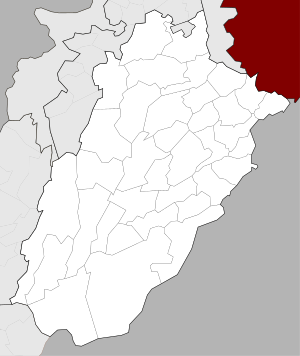Nankana Sahib
| Nankana Sahib ننكانہ صاحِب | |
|---|---|
| City | |
| The City of Nankana Sahib | |
|
| |
 Nankana Sahib  Nankana Sahib | |
| Coordinates: 31°27′0″N 73°42′24″E / 31.45000°N 73.70667°ECoordinates: 31°27′0″N 73°42′24″E / 31.45000°N 73.70667°E | |
| Country | Pakistan |
| Province | Punjab |
| District | Nankana Sahib |
| Government | |
| Elevation | 187 m (614 ft) |
| District Council | 3 seats |
Nankana Sahib (Punjabi and Urdu: ننكانہ صاحِب) is a city and capital of Nankana Sahib District in the Punjab province of Pakistan. It is named after the first Guru of the Sikhs, Guru Nanak, who was born in the city and first began preaching here. Today it is a city of high historic and religious value and a popular pilgrimage site for Sikhs from all over the world.[1][2] It is located about 80 km (50 mi) west of Lahore and about 75 km (47 mi) east of Faisalabad.[3] The city has a population of approximately 70,000.[4]
History
The township was founded by Rai Bhoi, a rich landlord Rajput Muslim and thus was known as Rai-Bhoi-Di-Talwandi.[5] His great-grand son Rai Bular Bhatti, renamed it as 'Nankana Sahib' after the birth of Guru Nanak. The Gurdwara Nankana Sahib, originally constructed in around 1600 CE was renovated in 1819–20 CE by Gian-Punjab Maharaja Jassa Singh Ramgarhia The Sikh Conference of Panjab, Jammu and Kashmir, Peshawar, Kangra and Hazara.
During the Akali movement, on 20 February 1921, Narain Das, the Udasi mahant (clergy) of the gurdwara at Nankana Sahib, ordered his men to fire on Akali protesters, leading to the Nankana massacre. The firing was widely condemned, and an agitation was launched until the control of this historic Janam Asthan Gurdwara was restored to the Sikhs.[6] Again in the 1930s and 40's the Sikhs added more buildings and more architectural design.
Migration between India and Pakistan was continuous before independence. By the 1940s Western Punjab was predominantly Muslim and supported the Muslim League and Pakistan Movement. After independence in August 1947, the minority Sikhs and Hindus migrated to India while the Muslim refugees from India settled in the Western Punjab and across Pakistan.[7]
Nankana Sahib and it surroundings were formerly a tehsil of Sheikhupura District. In May 2005, the provincial government raised the status of Nankana Sahib to a district[8] as a way of promoting development in the area. The present status is District Nankana Sahib has three tehsils: Nankana Sahib, Shah Kot, and Sangla Hill. Before December 2008, District Nankana Sahib also included Safdarabad Tehsil.
There are plans to construct a 100 acres (40 ha) university as well as hospitals and health care facilities by the district government with mutual interest of local communities and family of Rai Bular.[9]
In 2007, the Pakistan government announced a plan to set up a university on Sikh religion and culture at Nankana Sahib, the birthplace of Guru Nanak. Chairman of Pakistan's Evacuee Trust Property Board (ETPB), Gen (R) Zulfikar Ali Khan, said that "The international Guru Nanak University planned at Nankana Sahib would have the best architecture, curricula and research centre on Sikh religion and culture", .[10]
Notable Places
- Quba Masjid (A replica of Quba Masjid of Madina)
- Gurdwara Janam Asthan
- Residency of Baba Guru Nanak
Notable Personalities
- Guru Nanak founder and first of the Sikh gurus
- Babra Sharif film actor
- Mohammad Irfan Pakistani cricketer
- Ijaz Shah
- Mehwish Iqbal
- Rai Mansab Ali Khan
- Shizra Mansab Ali Khan
- Ganga Ram
- Barjees Tahir
- Hercharn Singh
Education
Universities/Higher Education Institutes
Schools
Police Stations
There are two Police stations in Nankana Sahib
- Police Station City Nankana Sahib
- Police Station Sadar Nankana Sahib
Hospitals
- District Head Quarter Hospital
References
- ↑ Iqbal, Amjad (22 November 2015). "Over 2,500 Indian Sikhs attend annual pilgrimage". DAWN.COM. Retrieved 20 April 2016.
- ↑ Historical Gurudwaras:Nankana Sahib Archived 2011-09-14 at the Wayback Machine.. Sgpc.net. Retrieved on 2011-11-15.
- ↑ Nankana Sahib. Nha.gov.pk. Retrieved on 2011-11-15.
- ↑ "World Gazetteer estimate for Nankana Sahib". Archived from the original on February 9, 2013. . World-gazetteer.com. Retrieved on 2011-11-15.
- ↑ Khalsa, Sukhmandir (1 January 2010). "Historical Gurdwaras of Nankana, Pakistan Commemorating Guru Nanak Dev". About.com Religion & Spirituality. Retrieved 20 April 2016.
- ↑ Singh, Roopinder (March 23, 2011). "Bhagat Singh: The making of the revolutionary". The Tribune. Retrieved 2011-10-23.
Bhagat Singh was a well-read, articulate young man who significantly impacted Indian history and left behind a legacy that even 80 years after his martyrdom is still very much a part of our cultural ethos
- ↑ Dube, I. &. S. (2009). From ancient to modern: Religion, power, and community in India hardcover. Oxford University Press.
- ↑ Nankana becomes a district. Dawn.com. Retrieved on 2011-11-15.
- ↑ "Nankana Sahib in Pak to be a recreational village". The Times of India. Sep 27, 2003. Retrieved 2011-10-23.
- ↑ "Pak govt plans university at Nankana Sahib". The Times of India. Apr 17, 2007. Retrieved 2011-10-23.
| Wikivoyage has a travel guide for Nankana Sahib. |